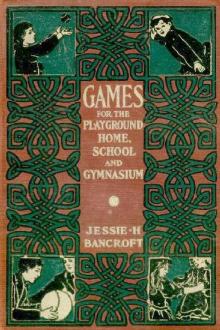Games for the Playground, Home, School and Gymnasium by Jessie Hubbell Bancroft (top novels of all time .txt) 📕

- Author: Jessie Hubbell Bancroft
- Performer: -
Book online «Games for the Playground, Home, School and Gymnasium by Jessie Hubbell Bancroft (top novels of all time .txt) 📕». Author Jessie Hubbell Bancroft
The players are divided into two equal parties, each under the command of a general, who may order his men at any time to any part of the battle. One party of players are defenders of the fortress, and should scatter over it at the beginning of the attack and keep a sharp lookout on unguarded parts at any time. The other players, forming the attacking party, scatter under the direction of their general to approach the fortress from different directions. This may be done in a sudden rush, or deliberately before attacking. At a signal from their general, the besiegers attack the fortress.
The method of combat is entirely confined to engagements between any two of the opposing players, and is in general of the nature of a "tug of war." They may push, pull, or carry each other so long as they remain upright; but wrestling or dragging on the ground are not allowed. Any player so forced over the guard line becomes a prisoner to his opponent and is thereafter out of the game. If he be a besieger, captured by a defender, he is placed within the prison in the center of the fortress, and may not thereafter escape or be freed unless the general should make an exchange of prisoners. Should he be a defender, pulled over the outer guard line by a besieger, he is taken to the prison of the attacking party, subject to the same rules of escape. In the general engagement, players of equal strength should compete, the strong players with strong ones, and vice versa. The commanders should each give general directions for this to their men before the engagement opens.
The battle is won by either party making prisoners of all of the opponents. Or it may be won by the besiegers if one of their men enters within the guard line inside the fortress without being touched by a defender. Should a player accomplish this, he shouts "Hole's won!" Whereupon the defenders must yield the fortress, and the two parties change places, defenders becoming besiegers, and vice versa. The possibility of taking the fortress in this way should lead to great alertness on the part of the defenders, as they should leave no point unguarded, especially a fence the enemy might scale. The guard line should be drawn inside any such boundaries, and a player entering in this way must of course get inside the guard line as well as over the fence. The attacking party on its part will use all possible devices for dashing into the fortress unexpectedly, such as engaging the players on one side of the fort to leave an unguarded loophole for entering at another.
The attacking general may withdraw his forces at any time for a rest or for conference; either general may run up a flag of truce at any time for similar purposes. Under such conditions the generals may arrange for an exchange of prisoners; otherwise there is no means of freeing prisoners.
FOX AND GEESE(For other games sometimes known by this title, see Fox Trail and, in the division of Quiet Games, Naughts and Crosses.)
10 to 30 or more players.
Playground; gymnasium.
One player is chosen to be fox and another to be gander. The remaining players all stand in single file behind the gander, each with his hands on the shoulders of the one next in front. The gander tries to protect his flock of geese from being caught by the fox, and to do this spreads out his arms and dodges around in any way he sees fit to circumvent the efforts of the fox. Only the last goose in the line may be tagged by the fox, or should the line be very long, the last five or ten players may be tagged as decided beforehand. It will be seen that the geese may all coöperate with the gander by doubling and redoubling their line to prevent the fox from tagging the last goose. Should the fox tag the last goose (or one of the last five or ten, if that be permissible), that goose becomes fox and the fox becomes gander.
A good deal of spirit may be added to the game by the following dialogue, which is sometimes used to open it:—
The fox shouts tantalizingly, "Geese, geese, gannio!"
The geese reply scornfully, "Fox, fox, fannio!"
Fox, "How many geese have you to-day?"
Gander, "More than you can catch and carry away."
Whereupon the chase begins.
This game is found in almost all countries, under various names and representing different animals.
FOX AND SQUIRREL20 to 60 players.
Schoolroom.
The players sit in their seats facing toward the aisles, so that each two adjacent lines have their feet in the same aisle and face each other. The game consists in passing or tossing some object (the squirrel), such as a bean bag, basket ball, or hand ball from one player across the aisle to another and back again, zigzagging down each aisle, to be followed at once by a second object (the fox); the effort being to have the fox overtake the squirrel before the end of the line is reached.
With very little children, passing is better than tossing; but with older children, or even with little ones, when more experienced, it is well to use the game as a practice for tossing and catching. The action should be very rapid. The game makes much sport for young children, and they are very fond of it.
FOX TRAIL (DOUBLE RIM)3 to 30 or more players.
Out of doors; indoors; snow.
This form of Fox Trail, like the Single Rim game, is distinctively a snow game, but may be used anywhere that a large diagram may be marked on the ground or floor. This game differs from the Single Rim in the size and complexity of the diagram, there being two rims to the wheel instead of one. It also differs in the fact that there is one more player than the number of dens for the foxes, and in the methods by which the foxes may run or be chased.
A large diagram is drawn on the ground, resembling a wheel with two rims. In the snow this is trampled with the feet like a path; on bare ground or damp sand it may be drawn with the foot or a stick; in the gymnasium or on a pavement it may be drawn with chalk. The outer rim should measure from thirty to forty feet in radius; the inner rim should be ten feet from this. Across the circles are drawn straight lines resembling the spokes of a wheel, the number being governed by the number of players. Where these spokes touch the outer rim, a den or goal is marked for the foxes, there being one goal less than the number of foxes.
One player, who is chosen as hunter, stands at his goal in the center or hub of the wheel. The balance of the players, who are foxes, take each a place in a den on the outer rim, with the exception of the odd fox, who stands elsewhere on the rim, trying to get a den whenever he can. The object of the game is for the foxes to run from den to den without being caught by the hunter. The method of running, however, is restricted. Both foxes and hunter are obliged to keep to the trails, running only on the lines of the diagram.
It is considered poor play to run from den to den around the outer rim, as there is practically no risk in this. The foxes may run in any direction on any trail, on the spokes of the wheel, or on either of the rims. They may turn off on the intersecting trail at any point, not being obliged to run entirely across to the opposite side of the rim, as in the simpler diagram given for the other game of this name. No fox, however, may turn back on a trail; having once started, he must keep on to the next intersecting point. Whenever the hunter succeeds in tagging a fox, the two players change places, the fox becoming hunter and the hunter fox.
This game is excellent sport, and is one of the most interesting and popular of the chasing games. It is one of the very few distinctive snow games.
FOX TRAIL (SINGLE RIM)3 to 20 players.
Out of doors; snow; seashore; gymnasium.
This is one of the few distinctive snow games, but may be played anywhere that a large diagram may be outlined on the ground. It is very popular with children, and makes an admirable game for older players as well. See the more complicated form, with double-rim diagram, preceding this.
A large circle from fifteen to thirty feet in diameter should be marked on the ground and crossed with intersecting lines like the spokes of a wheel, there being about five such lines (ten spokes). The more players there are, the larger should be the circle and the greater the number of spokes; but there is no fixed relation between the number of spokes and players. If played in the snow, this diagram may be trampled down with the feet; if on the fresh earth or sand, it may be drawn with the heel or a stick; or if in a gymnasium or on a pavement, marked with chalk.
One player is chosen to be It or Hunter. He stands in the center, that is, on the hub of the wheel. The other players scatter around the rim and are foxes. They are not stationed at any one point as in the Double Rim game, but run or stand anywhere around the rim when not dashing across the spokes. The object of the game is for the foxes to cross the wheel to some opposite point without being tagged by the hunter. They may only run, however, on the prescribed trails,—that is, on the lines of the diagram. In this form of the game (the Single Rim diagram) they may run only straight across, and are not at liberty to turn an angle at the hub and seek refuge over any other trail than the direct continuation of the one on which they started. The hunter changes places with any one whom he tags.
FRENCH TAG4 to 60 or more players.
Indoors; out of doors.
In this form of tag certain boundaries are agreed upon beyond which players may not run, though they may climb or jump over any obstacles within the boundaries.
Any player who goes outside of the bounds is at once declared to be It by the pursuer. Otherwise the game is like ordinary tag, any player who is tagged by the chaser becoming It. (See Tag.)
FROG IN THE MIDDLE10 to 30 or more players.
Parlor; gymnasium; playground.
One player is chosen for the frog, and sits





Comments (0)